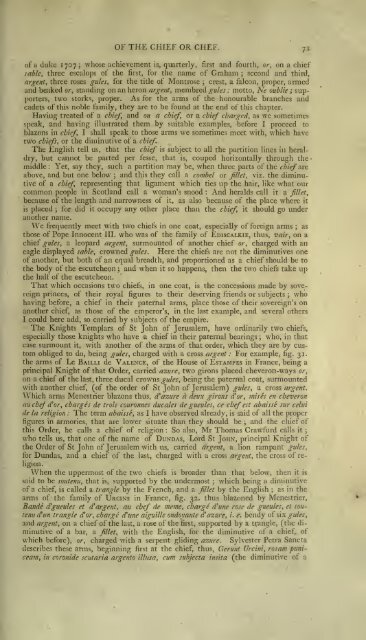A System of Heraldry - Clan Strachan Society
A System of Heraldry - Clan Strachan Society
A System of Heraldry - Clan Strachan Society
Create successful ePaper yourself
Turn your PDF publications into a flip-book with our unique Google optimized e-Paper software.
OF THE CHIEF OR CHEF. 7 r<br />
<strong>of</strong> a duke 1707; whose achievement is, quarterly, first and fourth, or, on a chief<br />
sable, three escalops <strong>of</strong> the first, for the name <strong>of</strong> Graham second and ; third,<br />
argent, three roses gules, for the title <strong>of</strong> Montrose ; crest, a falcon, proper, armed<br />
and beaked or, standing on an heron argent, membred gules : motto, Ne oublie ; sup-<br />
porters, two storks, proper. As for the arms <strong>of</strong> the honourable branches and<br />
cadets <strong>of</strong> this noble family, they are to be found at the end <strong>of</strong> this chapter.<br />
Having treated <strong>of</strong> a chief, and on a chief, or a chief charged, as we sometimes<br />
speak, and having illustrated them by suitable examples, before I proceed to<br />
blazons in chief,<br />
I shall speak to those arms we sometimes meet with, which have<br />
two chiefs, or the diminutive <strong>of</strong> a chief.<br />
The English tell us, that the chief is subject to all the partition lines in heral-<br />
dry, but cannot be parted per fesse, that is, couped horizontally through the<br />
middle : Yet, say they, such a partition may be, when three parts <strong>of</strong> the chief are<br />
above, and but one below ; and this they call a combel or fillet, viz. the diminutive<br />
<strong>of</strong> a chief, representing that ligament which ties up the hair, like what our<br />
common people in Scotland call a woman's snood : And heralds call it a fillet,<br />
because <strong>of</strong> the length and narrowness <strong>of</strong> it, as also because <strong>of</strong> the place where it<br />
is placed ; for did it occupy any other place than the chief, it should go under<br />
another name.<br />
We frequently meet with two chiefs in one coat, especially <strong>of</strong> foreign arms ; as<br />
those <strong>of</strong> Pope Innocent III. who was <strong>of</strong> the family <strong>of</strong> EDISCALKIE, thus, vair, on a<br />
chief gules, a leopard argent, surmounted <strong>of</strong> another chief or, charged with an<br />
eagle displayed sable, crowned gules. Here the chiefs are not the diminutives one<br />
<strong>of</strong> another, but both <strong>of</strong> an equal breadth, and proportioned as a chief should be to<br />
the body <strong>of</strong> the escutcheon ; and when it so happens, then the two chiefs take up<br />
the half <strong>of</strong> the escutcheon.<br />
That which occasions two chiefs, in one coat, is the concessions made by sovereign<br />
princes, <strong>of</strong> their royal figures to their deserving friends or subjects ; who<br />
having before, a chief in their paternal arms, place those <strong>of</strong> their sovereign's on<br />
another chief, as those <strong>of</strong> the emperor's, in the last example, and several others<br />
I could here add, so carried by subjects <strong>of</strong> the empire.<br />
The Knights Templars <strong>of</strong> St John <strong>of</strong> Jerusalem, have ordinarily two chiefs,<br />
especially those knights who have a chief in their paternal bearings ; who, in that<br />
case surmount it, with another <strong>of</strong> the arms <strong>of</strong> that order, which they are by custom<br />
obliged to do, being gules, charged with a cross argent : For example, fig. 31.<br />
the arms <strong>of</strong> Le BAILLI de VALENCE, <strong>of</strong> the House <strong>of</strong> ESTAMPES in France, being a<br />
principal Knight <strong>of</strong> that Order, carried azure, two girons placed cheveron-ways or,<br />
on a chief <strong>of</strong> the last, three ducal crowns gules, being the paternal coat, surmounted<br />
with another chief, (<strong>of</strong> the order <strong>of</strong> St John <strong>of</strong> Jerusalem) gules, a cross argent.<br />
W T<br />
hich arms Menestrier blazons thus, fazure a deux girons d'or, mises en cheveron<br />
mi cbef d'or, charges de trois couronnes dueales de gueules, ce chef est abaisse sur celui<br />
de la religion : The term abaisse, as I have observed already, is said <strong>of</strong> all the proper<br />
figures in armories, that are lower situate than they should be ; and the chief <strong>of</strong><br />
this Order, he calls a chief <strong>of</strong> religion : So also, Mr Thomas Crawfurd calls it ;<br />
who tells us, that one <strong>of</strong> the name <strong>of</strong> DUNDAS, Lord St JOHN, principal Knight <strong>of</strong><br />
the Order <strong>of</strong> St John <strong>of</strong> Jerusalem with us, carried argent, a lion rampant gules,<br />
for Dundas, and a chief <strong>of</strong> the last, charged with a cross argent, the cross <strong>of</strong> re-<br />
ligion.<br />
When the uppermost <strong>of</strong> the two chiefs is broader than that below, then it is<br />
said to be soutenu, that is, supported by the undermost ; which being a diminutive<br />
<strong>of</strong> a chief, is called a trangle by the French, and a fillet by the English ; as in the<br />
arms <strong>of</strong> the family <strong>of</strong> URCINS in France, fig. 32. thus blazoned by Menestrier,<br />
Bande d'guettles et d'argent, au chef de meine, charge d'une rose de gueules, et sou-<br />
tenu d'un trangle d'or, charge d'une aiguille ondoyante d'azi/re, i. e. bendy <strong>of</strong> six gules,<br />
and argent, on a chief <strong>of</strong> the last, a rose <strong>of</strong> the first, supported by a trangle, (the diminutive<br />
<strong>of</strong> a bar, a fillet, with the English, for the diminutive <strong>of</strong> a chief, <strong>of</strong><br />
which before), or, charged with a serpent gliding azure. Sylvester Petra Sancta<br />
describes these arms, beginning first at the chief, thus, Gerunt Urcini, rosam puniceam,<br />
in coronide scutaria argento illusa, cum subjecta insita (the diminutive <strong>of</strong> a




